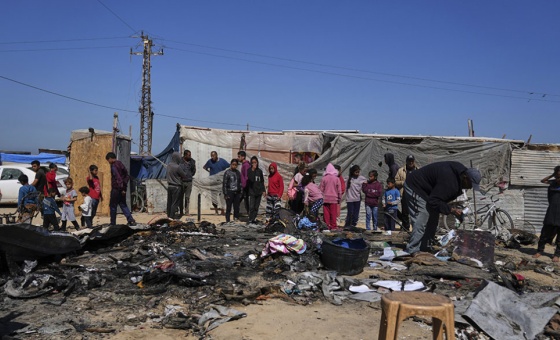This is the last article you can read this month
You can read more article this month
You can read more articles this month
Sorry your limit is up for this month
Reset on:
Please help support the Morning Star by subscribing here
SAND is a familiar sight to all of us, from our earliest years — sandpits in the playground, sandy beaches by the ocean. But sand is much more important than most people know.
In fact, together with gravel, it is one of the most extracted resources on the planet, second only to water. The rate of extraction and trade of sand by volume exceeds even fossil fuels. Sand and gravel are the foundational materials for infrastructure, and the construction industry heavily relies on them.
Without sand and gravel, our industrialised world would grind to a halt: no more concrete, asphalt or glass to build houses, hospitals, schools, roads, and much other infrastructure central to the society we live in.
Water treatment and renewable energy sources such as solar panels rely on sand as a raw material, too. And of course, so do electronics such as phones and computers. The list is seemingly endless. But sand itself is not.
Globally, 40 to 50 billion metric tons of sand are used every year, and demand is predicted to outstrip supply by the middle of this century, as natural sand replenishment rates are far lower than consumption rates.
Although sand might seem like an infinite resource — don’t we have huge areas of desert across the world? — the type of sand needed for industrial production is the coarser, more angular kind found in rivers. Sand extraction is one of the least regulated industries across the world, leading to uncontrolled extraction processes that are directly harmful to the environment.
Sand and gravel are permeable, meaning water can flow through layers of sand and gravel in the ground. These layers hosting groundwater are known as aquifers, and they provide a major source of freshwater.
Mining these sand and gravel layers lowers the water table — the depth below which the ground is saturated with water. This is environmentally disastrous, not least because it exacerbates drought. A study conducted in Manimala river in south-western India, a sand mining site, found that more than 60 per cent of the wells in the river’s floodplain area were affected by water shortages.
The extraction of sand and gravel from rivers also hastens erosion, causing the removal of banks and islands within rivers. The damage can be seen from space, as in the satellite images of the Umngi River in northern Bangladesh and the Potomac estuary of Virginia in the US, which reveal the impact of sand mining on the shape and flow of these rivers.
The increased instability of riverbanks resulting from extraction can have devastating impacts on communities and cities built close by. The Mekong Delta in Vietnam is home to over 500,000 people, all of who are at risk of losing their homes due to the possibility of riverbank collapse caused by sand mining in the channel. Critical infrastructure like bridges and roads are also threatened.
Eroded riverbanks and the lowering of the water table don’t just put humans at risk. Sand mining also endangers the flora and fauna of river and coastal environments.
A collection of 10 studies collated by the World Wildlife Foundation all concluded that sand and gravel mining negatively impacted native fish populations.
This isn’t just because some mining processes directly kill fish, for example, with toxic runoff, but also due to channel alterations, the destruction of spawning grounds and interference with migratory routes. Vegetation also suffers, often by being directly removed for mining, but also through changes in soil profiles and the hydrology and topography of the area.
The negative impacts of sand extraction are manifold, and their consequences are far-reaching. The situation may seem bleak in the face of a capitalist economic system that is geared to ever-more expansive development and industrialisation. However, alternatives are being sought.
China is leading the way in innovating sustainable infrastructure in its new city projects; for example, replacing traditional concrete and asphalt roadways, pavements and parking lots with permeable paved surfaces.
This green infrastructure reduces surface runoff and urban flooding, an inevitability when cities are paved with impermeable materials like concrete. Most permeable pavement designs use little to no sand, meaning the construction of these surfaces reduces the demand for natural sand.
Another alternative is to use manufactured sand from crushed rocks, quarry stones and tailings rather than extracting it: a less ecologically damaging and more sustainable alternative.
Recent research published in Nature Geoscience, led by Heming Wang, Peng Wang and Xu Zhang, shows that while China’s overall sand supply increased by a staggering 400 per cent in the years 1995 to 2020, this increase was almost all in manufactured sand.
In 1995, 80 per cent of the sand supplied was natural; in 2020, only 21 per cent was natural. In 2010, China introduced strict regulations on natural sand mining in rivers, leading to a halving in natural sand supply over the following decade.
These regulations formed part of the River Chief System, a nationwide action to protect water resources, control pollution, improve the environment and restore natural communities worldwide.
More urban development cannot be avoided, with the world’s population set to reach 9 billion within the next 15 years. We all need infrastructure to house, heal and transport us, and provide us with clean drinking water and renewable energy — all of which currently rely heavily on sand mining.
It is a reminder that modern civilisation rests on many forms of extraction, not just fossil fuels. But there is hope. By transitioning to green infrastructure, looking for manufactured alternatives to sand, and heavily regulating mining industries, it is possible to turn the tide on sand extraction’s destructive potential.







